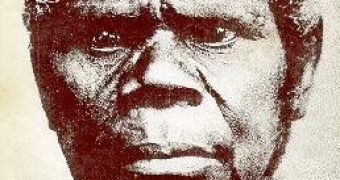You surely have heard about the Tasmanian devil. You understand why devil, but what do you know about the island of Tasmania?
It is a land located between 40o 38' and 43o 39' S, off southeastern Australia, being slightly larger than the island of Ireland (with a similar clime, too). The wet cool temperate climate is very contrasting, with powerful west winds. July and August are the coldest months of the year (that is the Austral winter). The winters are mild and the summers rather cool.
30,000 years ago, at the peak of the last glaciation, the sea levels were much lower and Tasmania was a peninsula of Australia. 10-15,000 years ago, when the ice packs started to melt and the sea level rose, Tasmania turned into an island isolated from the mainland. 40,000 years ago, Aborigines had entered Australia and those in Tasmania got isolated from those on the continent.
Tasmanian Aborigines are said to have looked somehow differently from those on the mainland. They were shorter and stalker, with dark skin, flattened nose, wide nostrils, thick lips, woolly hair and harsh beards. They did not wear clothes and anointed their skin with fats or colored it with ocher-red pigments. They were nomad and lived in groups of about 30 individuals.
They did not know how to ignite fire, but used those caused by lightning and kept fire by carrying brands with them. They used fire for burning the forest during the hunts, for inciting the game. In the summer, the Tasmanian Aborigines inhabited the central part of the island; in the winter they moved to the shores of the island, as the central mountains were snowed. Before the European colonization, 2,000-5,000 Tasmanian Aborigines inhabited the island, distributed in 6 tribes speaking 6 different languages.
Tasmania was first spotted by the Europeans on the 14th of August, 1642, during an expedition led by the Dutch explorer Abel Jaanszon Tasman. But the first registered encounter between the Tasmanian Aborigines and Europeans took place in 1772, during the expedition led by the French Morion de Fresna, when at least one Aborigine was killed. The French Entrecastreaux visited the island in 1792 and baptized its largest river Huon, after the name of its first mate, Huon Kermadec.
In 1798, Flinders and Bas prove that Tasmania is just an island and made its tour (today, the strait between Australia and Tasmania is called Bas Strait). In 1802, Baudin explores the south coast of the island, which he baptized 'The Napoleon Coast'. In 1803, the British founded the first colony in Tasmania, in which the most dangerous prisoners were brought from an annex of prison of New South Wales (Australia). Next year, the Black War started: Whites attacked the Tasmanian Aborigines, killing the men and raping their women.
In 1819, Tasmania starts to export wool and wheat. On the former hunting grounds of the Aborigines, farms started to flourish, due to the cheap handwork made by convicted. Left in a state of semi-freedom, the convicted would abuse of the Aborigines. In 1831-1835, the authorities saved the last 200 Tasmanian aborigines from the Flinders Island. But these too were to die because of the diseases brought by Europeans. In 1869, just one pure blooded Tasmanian Aborigine existed: a woman called Truganini. She died in 1879. Only mulattoes survived. It is the first historically documented disappearance of a human race.
On the 25th of December 1865, Tasmania changed its name from Van Diemen (given by Tasman) into its current one. 400,000 people inhabit the island today, and the same number visits it annually.
One quarter of the income of Tasmania comes from the mines of zinc, lead, copper, tin, tungsten, silver and gold. In the eastern part of the island, the higher temperatures are proper for sheep and cattle husbandry and also for the cultivation of cereals and fruit trees. The west, more humid, is the land of the wild forests, lakes and peat swamps. The soils of these areas are either too rocky, or very acid and wet. 40 % of Tasmania is covered by forests, 22 % representing natural reserves and resort areas. The first national park in Tasmania was founded in 1919.
Tasmania was the home of the emblematic marsupial carnivorous: the Tasmanian tiger (Thylacinus) and the Tasmanian devil (Sarcophilus). None has any connection with the carnivorous in other lands. After humans entered Australia, only these two large carnivores roamed the lands.
But when the Dingo (Canis lupus dingo) was brought to Australia 3,500-4,000 years ago by seafarers from Indonesia, these marsupial carnivores were doomed. The dingo was also in advantage because of the social structure and hunting in packs (just like any other wolf), while the thylacine hunted alone. The devil relied on the carcasses left by the thylacine. The thylacine's extinction on the Australian mainland could have been also hurried up by a climate change and a shift in Aboriginal land-use patterns.
They persisted only on the island of Tasmania, unreached by dingoes.
But after the European colonization, the Tasmanian tiger shared the faith of the Tasmanian Aborigines. It was believed the wolf-like carnivore could kill sheep (fact infirmed by the scientists) and poultry. Exported to zoos, killed by farmers and hunters (up to 2,000 government bounties were given between 1888 and 1912), the Tasmanian population of about 5,000 thylacines disappeared quickly: the last one died in a Tasmanian zoo in 1936. The settlers too competed with the thylacines for food, as they chased small animals, decreasing their numbers, and induced environmental changes.
Only the devil survived. Being smaller, it had larger numbers, and when protection was installed, this funny noisy animal, with an extremely powerful denture, could be saved. Now, the emergence of red foxes and a cancer-causing virus are putting its existence to a serious threat.

 14 DAY TRIAL //
14 DAY TRIAL //